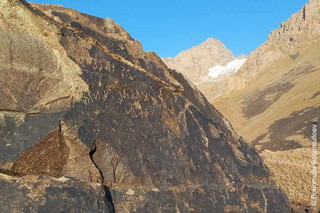Dr Svenja Bonmann at the University of Cologne’s Department of Linguistics and Dr Jakob Halfmann at the University of Würzburg’s Department of Ancient Studies have received research funding from the Fritz Thyssen Foundation to study further inscriptions of the so-called Issyk-Kushan script in Tajikistan, Uzbekistan and Kazakhstan. On the one hand, they plan to analyse inscription material already identified in museum collections. On the other, they will document promising sites in the three countries that are presumed to be evidence of the writing system. Phases of conducting research in the field will alternate with analysis and evaluation phases in Germany. The research project ‘A Digital Corpus of the Issyk-Kushan inscriptions’ will begin on 1 January 2025 and will initially run for two years with the option to extend for a further year. The two participating universities will share a total of 200,000 euros in funding.
In an area stretching from the Kazakh Ili Valley to the southern Hindu Kush, archaeological excavations since the late 1950s have uncovered several dozen inscriptions in an undeciphered writing system that was later referred to as the ‘unknown script’. Most of these inscriptions have been dated to the period between 200 BCE and 300 CE and attributed to ancient Bactria. Bonmann and Halfmann solved the puzzle with another colleague in 2022/23 and partially deciphered the writing system. They used a bilingual inscription (Almosi bilingual) recently discovered in the Almosi Gorge in Tajikistan and a trilingual inscription (Dašt-i Nāwur trilingual) discovered in the 1960s not far from Kabul. The result is considered to be the first successful deciphering of a writing system in seventy years.
Preliminary results of the investigation suggest that the script was used to record a previously unknown Middle Iranian language, at least in the area where it was found. Bonmann and Halfmann gave the newly identified language the provisional name ‘Eteo-Tocharian’, referring to the Yuezhi-Tocharians described in ancient sources. They suggested the name ‘Issyk-Kushan script’ for the formerly ‘unknown script’, since its connection with the ruling dynasty of the Central Asian Kushan Empire is undeniable.
The aim of the planned research visits is to deepen the linguistic understanding of the Issyk-Kushan script, to continue work on the partially completed (around 60 per cent) deciphering of the writing system and to create a digital edition of all Issyk-Kushan inscriptions. Bonmann and Halfmann are compiling a complete collection of the ‘Eteo-Tocharian’ source texts with a catalogue and etymological dictionary of the language. They are also collaborating with Central Asian archaeologists to find new inscriptions in order to add significant new finds to the inscription corpus. Their collaboration partner from the Tajik National Academy of Sciences has already localized several potential new sites, including one in the Hissar Range called Sang-i Navišta (‘inscribed stone’).
The research funding allows the researchers to digitally catalogue, secure and research already known lssyk-Kushan inscriptions and to explore potential new sites. The results will allow them to learn more about the early linguistic history of Central Asia and to decipher the Issyk-Kushan script as completely as possible. This in turn would enable new historical research on the Kushan Empire.
Media Contact:
Dr Svenja Bonmann
Department of Linguistics
+49 221 470 4112
svenja.bonmannuni-koeln.de
Press and Communications Team:
Eva Schissler
+49 221 470 4030
e.schisslerverw.uni-koeln.de
